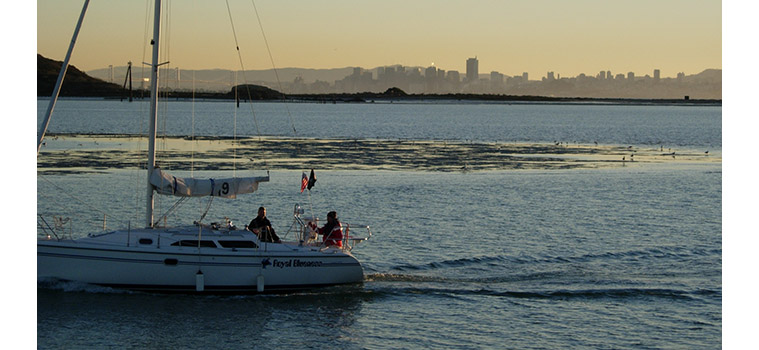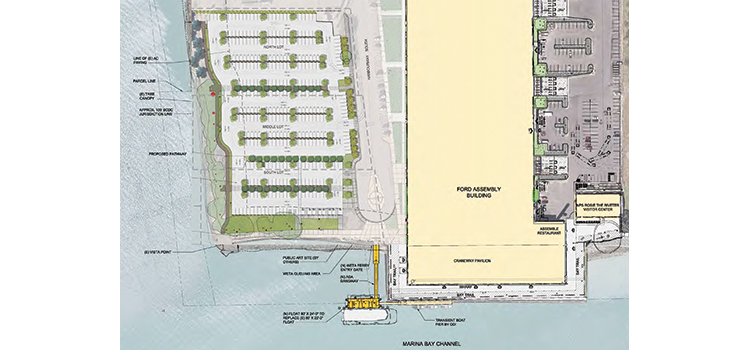The long-cherished goal of comprehensive regional ferry service takes a big step forward next fall with the launch of WETA/San Francisco Bay Ferry service connecting Richmond to San Francisco's Ferry Building.

The San Francisco skyline can be seen clearly from the shores of Richmond. Next year, ferry service will provide commuters with a traffic free way to get there in addition to BART. Photo by Joel Williams
BY BOBBY WINSTON
Published: September, 2017
The long-cherished goal of comprehensive regional ferry service takes a big step forward next fall with the launch of WETA/San Francisco Bay Ferry service connecting Richmond to San Francisco’s Ferry Building.
The new service, now scheduled for September 2018, caps over a decade of patient activism on the part of Contra Costa County transportation officials—egged on every step of the way by dogged ferry advocate Tom Butt, currently the mayor of Richmond.
Richmond’s opportunity for WETA ferry service cropped up when plans for service to Berkeley/Albany were shelved in the face of community opposition. A Contra Costa County taxpayer subsidy was an important factor in WETA’s determination to accept Richmond’s bid for the new service.
The new Richmond-Ferry Building service does not figure to be an overnight success. New services often experience low ridership at the start until word of mouth leads to widespread acceptance. Such was the pattern with Harbor Bay-Ferry Building service a decade or more ago and, most recently, with the South San Francisco-Alameda/Oakland service.
No doubt when word gets out about charming Point Richmond, a New England village with heart-stopping views of San Francisco and Mt. Tamalpias, denizens of the financial district will clamor to snap up homes there and enjoy the lifestyle and ferry commute, much like the experience in Alameda.
Indeed, if past is prologue, the problem will soon be too many riders trying to get aboard the two morning and two afternoon commuter runs initially planned for Richmond-Ferry Building service. This writer remembers well fighting to keep Harbor Bay service from cancellation due to low ridership—hard to imagine given today’s overflow passenger loads and fights over parking.
The Red & White Fleet offered private commuter ferry service from Richmond starting in 1999, but service was discontinued due to low ridership and the slow pace of the older vessels employed. More recently, Tideline offered water taxi service; this, too, was discontinued. In contrast with those services, however, WETA will use brand-new, purpose-built fast ferries on the service starting next year.
Ridership for the new Richmond-Ferry Building ferry figures to come initially from beleaguered East Bay commuters battling the notorious Eastshore Freeway’s hellacious traffic or seeking relief from BART’s inhumanly overcrowded trains. A prime attraction will be the virtually unlimited parking that is available at Richmond’s ferry landing next the Craneway Pavilion—acres upon acres of underused Port of Richmond lots sit immediately adjacent.
The addition of new service comes at a time of unbridled growth in ferry ridership—up more than 75 percent in the last five years (see story on page 15) with not enough space to park all the new ferry boats getting built and delivered. More figure to be on the way; the California Legislature is mulling plans for Regional Measure 3, a ballot measure asking to boost bridge tolls in order to fund transportation that will likely be considered in 2018.
Ferry advocates, led by Bay Area Council President and Executive Director (and WETA board member) Jim Wunderman, are much in the RM3 fray, fighting to ensure sufficient resources to cope with current ferry service shortcomings—not enough boats, principally—plus calls to take on new service in communities like Redwood City.
The competition is fierce, with every transit service and special interest jockeying to maximize RM3 allocations. As this story goes to press, lawmakers in Alameda and Contra Costa counties—where the preponderance of toll-payers live—are jousting with Santa Clara and San Francisco, where many fewer residents have cause to pay tolls.
The upshot is that more populous counties like Santa Clara and San Francisco figure to easily support toll increases they won’t have to pay for, yet will benefit from in large measure. Alameda and Contra Costa leaders are battling to make sure their toll-paying constituents are fairly treated.
So new ferry service for Contra Costa’s Richmond, in the works before RM3 was a gleam in transit planners’ eyes, comes at a particularly propitious time, demonstrating how regional cooperation can work for everyone in the Bay Area.

The new Richmond ferry terminal location next to the old Ford Assembly Building will offer ample parking for commuters to the San Francisco Ferry Building.

